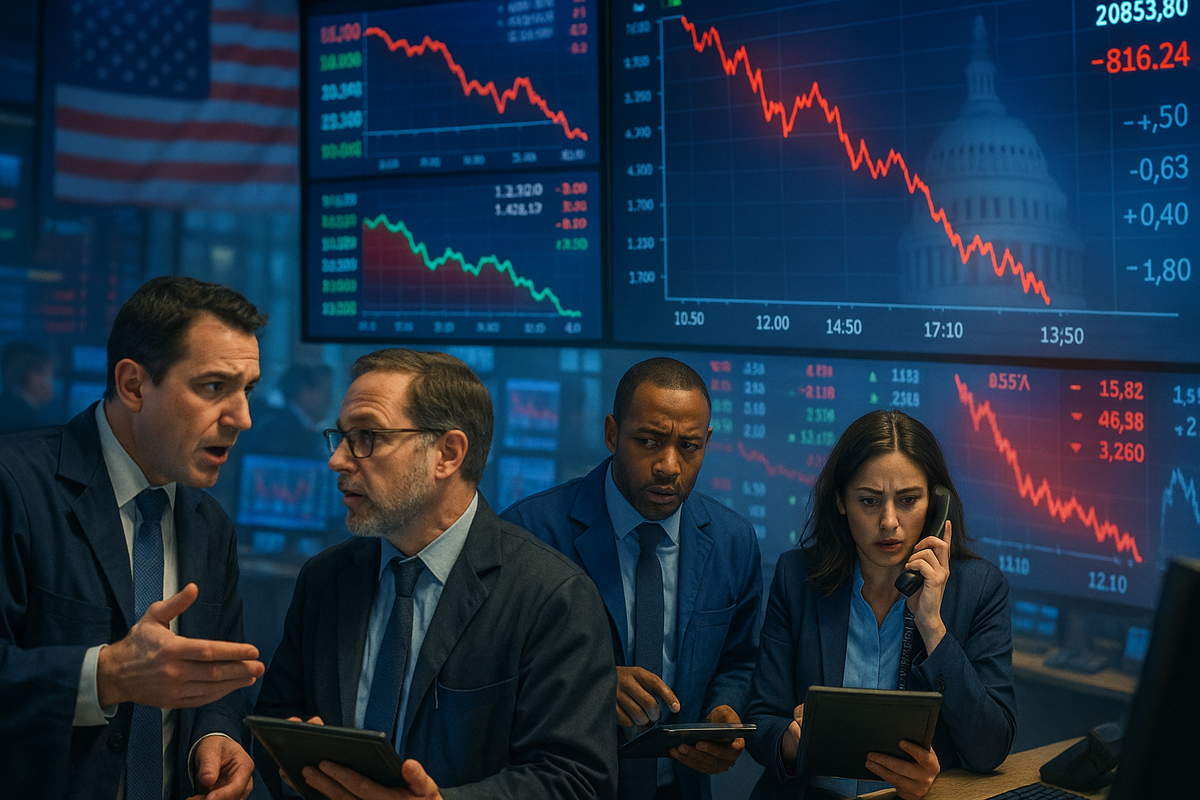Financial News
Political Tremors Rattle Markets: The Profound Impact of U.S. Elections and Tariff Shocks

The intricate dance between political shifts and financial markets has once again taken center stage, demonstrating the profound influence of electoral outcomes and subsequent policy decisions on global economies. The U.S. presidential election, a quadrennial event of immense significance, consistently introduces periods of heightened uncertainty and volatility, often culminating in dramatic market reactions. This dynamic was vividly illustrated during Donald Trump's 2016 election and, more recently, with the immediate and far-reaching effects of his tariff announcements in 2025, which sent shockwaves across international bourses.
These political events underscore a critical truth: while economic fundamentals often dictate long-term market trends, short-term investor sentiment and policy shifts can trigger immediate and substantial revaluations. The promise of deregulation and tax cuts under one administration, or the threat of trade wars under another, can swiftly alter the landscape for public companies and investors alike, demanding agile responses and a keen understanding of the evolving political climate.
The Trump Effect: From Election Rally to Tariff Turmoil
Donald Trump's victory in the 2016 presidential election delivered an immediate jolt to global financial markets. Initially, on election night, U.S. stock futures plummeted, with S&P 500 futures dropping over 5%, hitting a limit that prevented further declines. International markets mirrored this panic, with Japan's Nikkei 225 closing down 5.4% and Hong Kong's Hang Seng falling 2.2%. This initial reaction stemmed from the market's surprise at the unexpected outcome, as most analysts had priced in a Hillary Clinton win, and concerns over Trump's protectionist rhetoric.
However, the market's narrative took a dramatic turn the very next day. Despite the overnight panic, U.S. stock markets staged a remarkable recovery, with the Dow Jones Industrial Average, S&P 500, and NASDAQ Composite Indexes all posting gains by the closing bell. This swift turnaround was largely attributed to Trump's conciliatory victory speech, which offered a glimmer of hope to investors that his administration might adopt a more pragmatic approach to policy implementation than his campaign rhetoric suggested. This optimism fueled a sustained "Trump rally," driven by expectations of pro-business policies, including significant tax cuts and deregulation, leading to a 9.5% market increase for the S&P 500 following his surprise win.
Fast forward to 2025, and the market's relationship with Trump's policies has evolved, particularly concerning tariffs. On April 2, 2025, President Trump announced sweeping tariffs impacting nearly all sectors of the U.S. economy. This declaration triggered widespread panic selling across global stock markets, including the United States, resulting in the largest global market decline since the 2020 stock market crash. The following day, April 3, 2025, saw the NASDAQ Composite lose a staggering 1,600 points (5.9%), marking its worst one-day performance since March 2020. The S&P 500 fell 4.5% and the Dow dropped 3.4% at opening, with the S&P 500 ultimately losing 4.84% of its value by the end of the day. The Russell 2000, representing small-cap companies, led losses by falling 6.59%, officially entering a bear market. Bloomberg estimated that approximately $2 trillion was wiped off the value of the S&P 500 index on April 3, 2025, alone, with tech giants like Apple (NASDAQ: AAPL) among the significant fallers. Over three days, an estimated $10 trillion in global equity value was lost. These tariffs included a 10% baseline tax on imports from all countries, with higher rates for nations running trade surpluses with the U.S., such as a 34% tax on imports from China, 20% on the European Union, 25% on South Korea, 24% on Japan, and 32% on Taiwan.
Winners and Losers in the Tariff Crossfire
The imposition of broad tariffs creates a complex web of winners and losers across various industries and companies. The immediate and most significant losers are typically companies heavily reliant on global supply chains and international trade, particularly those importing goods from countries targeted by higher tariffs. Technology companies, for instance, often have intricate global supply chains, making them highly vulnerable. Apple (NASDAQ: AAPL), as noted, was among the significant fallers following the April 2025 tariff announcements, reflecting its reliance on manufacturing and components sourced from affected regions.
Similarly, sectors like pharmaceuticals and semiconductors faced direct threats. In August 2025, Trump's plans to impose tariffs as high as 250% on pharmaceuticals and separate levies on semiconductors and chips led to U.S. stocks ending in negative territory, with the Dow falling 0.14%, the Nasdaq down 0.65%, and the S&P 500 dropping 0.49%. Shares in European pharmaceutical companies also sank to a four-month low, highlighting the global ripple effect. Companies like Pfizer (NYSE: PFE), Merck (NYSE: MRK), and Johnson & Johnson (NYSE: JNJ), with extensive international operations and supply chains, would face increased costs and potential disruptions. Semiconductor giants such as NVIDIA (NASDAQ: NVDA) and Intel (NASDAQ: INTC), heavily dependent on global manufacturing and sales, would also be significantly impacted by tariffs on chips.
Conversely, potential "winners" from protectionist policies might include domestic industries that compete directly with imported goods, as tariffs make foreign products more expensive, theoretically boosting demand for domestically produced alternatives. However, the broad nature of the 2025 tariffs, impacting "nearly all sectors," suggests that even domestic companies could face increased input costs if they rely on imported raw materials or components, turning potential wins into complex challenges. Companies with robust domestic supply chains or those that can quickly pivot to local sourcing might be better positioned to weather the storm.
Industry Impact and Broader Implications
The profound impact of political events, particularly tariff announcements, extends far beyond individual companies, creating significant ripple effects across entire industries and the broader global economy. The 2025 tariffs, with their sweeping scope, represent a major disruption to established global trade patterns and supply chains. This event fits into a broader trend of increasing economic nationalism and protectionism, challenging the decades-long movement towards globalization and free trade.
The immediate consequence is heightened uncertainty, which is anathema to market stability. Businesses face unpredictable costs, disrupted supply chains, and reduced visibility into future profitability, leading to delayed investment decisions and a general slowdown in economic activity. Competitors and partners across the globe are also affected, as tariffs can alter competitive landscapes, force renegotiations of contracts, and even lead to retaliatory measures from other nations, escalating trade disputes into full-blown trade wars. This can fragment global markets, making it harder for multinational corporations to operate efficiently.
Regulatory and policy implications are immense. Governments may be forced to re-evaluate trade agreements, implement new subsidies or support programs for affected industries, and navigate complex diplomatic challenges. The World Trade Organization (WTO) could see increased disputes, further straining international trade relations. Historically, periods of high tariffs have often preceded economic downturns, as seen during the Great Depression, though modern economies are far more interconnected and diversified. The current situation underscores the fragility of global economic interdependence when confronted with unilateral policy shifts. The sheer scale of the $10 trillion global equity value loss in just three days following the 2025 tariff announcement highlights the immediate and severe financial consequences of such policies.
What Comes Next
The immediate aftermath of the sweeping 2025 tariffs suggests a period of sustained market volatility and economic uncertainty. In the short term, companies will be scrambling to assess the full impact on their supply chains, pricing strategies, and profitability. Many will likely explore options for diversifying their sourcing, relocating production, or passing increased costs onto consumers, which could fuel inflation. Investors should anticipate continued fluctuations as markets digest the implications of these tariffs and as companies release earnings reports reflecting the new cost structures.
In the long term, the landscape could see significant strategic pivots. Companies may accelerate efforts towards reshoring or nearshoring production to reduce reliance on international supply chains vulnerable to tariffs. This could lead to increased domestic manufacturing and job creation in some sectors, but also higher production costs overall. Market opportunities may emerge for logistics companies specializing in complex supply chain reconfigurations, or for domestic manufacturers who can scale up to meet new demand. Conversely, challenges will persist for exporters facing retaliatory tariffs and for consumers grappling with potentially higher prices for a wide range of goods.
Potential scenarios include a prolonged period of trade tensions, leading to a more fragmented global economy, or a eventual de-escalation if diplomatic efforts or economic pressures lead to a reduction or removal of tariffs. The latter could trigger a market rebound, similar to instances where the stock market surged after Trump confirmed a decrease in tariffs in the past. However, the current broad scope of the tariffs suggests a more entrenched policy stance. Companies will need to adapt by building more resilient and diversified supply chains, exploring new markets, and potentially lobbying for policy changes.
Conclusion
The recent political events, from the surprising 2016 election rally to the profound market shock of the 2025 tariff announcements, underscore the undeniable and often immediate impact of political decisions on financial markets. While the 2016 election initially spurred optimism based on promises of deregulation and tax cuts, the subsequent implementation of broad tariff policies has demonstrated the disruptive power of protectionism. The estimated $10 trillion in global equity value lost in just three days following the April 2025 tariff announcement serves as a stark reminder of the financial fragility in the face of such policy shifts.
Moving forward, investors must recognize that political risk remains a significant factor in market performance. The era of predictable global trade appears to be giving way to one of increased uncertainty and potential fragmentation. Companies will need to prioritize supply chain resilience, explore domestic production alternatives, and maintain agile business models to navigate the evolving trade landscape. What investors should watch for in the coming months includes further policy announcements, the extent of retaliatory measures from other nations, and the ability of companies to adapt their operations to the new tariff environment. The lasting impact of these events will likely be a re-evaluation of global supply chains and a heightened awareness of the interconnectedness between geopolitics and economic prosperity.
More News
View More





Quotes delayed at least 20 minutes.
By accessing this page, you agree to the following
Privacy Policy and Terms Of Service.



